
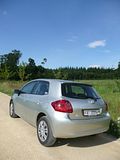

The first Toyota Corolla was launched over 40 years ago. The initial model, an 1100cc saloon, launched in 1967 delivered a perfectly, acceptable, but hardly exciting, and yet totally dependable package aimed at the family motorist. For those who thought about these things, it should have offered a real wake-up call to every established car maker. Few showed much sign of treating this newcomer as a serious threat, but as successive generations of the Corolla appeared – typically on a four year model cycle – and standards continued to improve, gradually, the true commercial significance of this car became more and more apparent. With the notable exception of the rear wheel coupes from the mid 80s and the GTi models of the late 80s, the car has rarely been seen as much more than automotive “white goods”. In fact, the last model to bear the Corolla name in Europe, the range launched in 2002, was generally hailed to be one of the very best cars in its class, and indeed my own findings were that this car had no significant weaknesses at all, and even the model I drove as recently as 5 months ago came across as competitive in what is a very hotly contested class. Rumour has it that Toyota were panicked into a more radical evolution than they had been planning when they saw the latest Honda Civic. Having now seen the result, the Auris, on our roads for just over a year, and finding it visually to be surprisingly similar to the car it replaced, I approached this test wondering if the most radical thing about the Auris was its use of a new name. Time to find out.

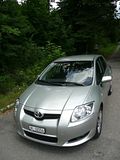
The test car, a 1.6 litre 5 door hatchback, had clearly had a very hard life in the Hertz Switzerland fleet. First registered in December 2007, it had 20,000 km on the clock, and as well as the usual scratches on various parts of the bodywork, the car came with two wheel trims missing (which is why the observant among you will spot that there are no pictures of the passenger side of the car!), a rear parcel shelf which had lost one of the retaining pivots, so if you allowed it to lift with the hatch, it ended up getting wedged in bodywork, and – and this seems to be surprisingly common in all Toyotas – much of the interior plastic especially around the ignition lock, and the handbrake looking very tatty and scratched indeed. So, it’s not just rental Fiat Grande Puntos that don’t last well, even the supposedly ever-reliable Toyota struggles when abused by the daily rental customer for 7 months.
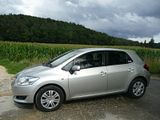

I got in the car, adjusted all the things that you adjust, put the key in, turned it and nothing happened! It’s a conventional key, and there was nothing to suggest that masonic hand-shakes in combination with the correct sequence of things to be pushed and pulled were required, and then I remembered that the Corolla Verso would only start with your foot hard down on the clutch, so I tried that, and the engine fired. During the day, when I was hopping in and out – especially during photography time – this actually proved quite annoying, but I supposed you would quickly get used to it. On looking around the inside, it quickly became apparent that although the outside might look like a variant of the Corolla, the inside is quite different. The dominating feature is the huge centre console area, on which the gearlever is mounted, very high up, to free a storage cubby area underneath. Although unusually high, the gearlever actually proved well positioned, and it fell to the palm of my hand quite readily when making gear changes. Nestling behind this is a handbrake which is almost vertical when it is set. A particularly nasty piece of cheap feeling chrome plated plastic acts as the release button which you push down, to release and set the brake. The handbrake lever itself was particularly scarred with scratches, but it did at least operate effectively. Although there is indeed a deep lipped cubby area under the gearlever, it proved very difficult to get to. It was far easier to reach round and grab items put there from the other side of the car than from where you were sitting. The console itself is very bulky, and left me with the impression of being somewhat shoe-horned into my space. The dash itself is quite different from that in the Corolla. For a start it is finished in a particularly horrible sort of plastic that tries hard to look like a sort of textured moulded rubber. I just thought it to be one of the more unpleasant finishes I had seen since the last Toyota in which I encountered it (a Yaris, I believe!). Things did not get a lot better when I looked at the dials. Behind a single glass screen are the two main dials, which lit up in orange once the ignition was on, but whose graphics were far from pleasant. The centre of each had an apparently raised area in which on the left were bar charts for fuel level and water temperature and on the right for the odometer and a couple of info displays. For a while, it looked as if there was no clock provided. I could not believe that a car would tell me the date and the outside temperature but not the time. By scrolling through the options from one of the buttons, I did find a setting to indicate the time. What is included is a “shift” light, which tells you when to change gear. Not once did I ever manage to get the “down shift” light to illuminate, even when I had slowed to the point that the engine was barely turning, but the upshift light seemed to cut in at about 2000 rpms, which, given the gearing, would have made acceleration somewhat marginal. I found the feature intensely irritating.There were wheel mounted controls for some of the stereo functions, but the unit itself had small fiddly, and very cheap feeling buttons. This car had air con, but not climate control, and despite playing with various settings, the unit did not prove that effective at getting much cool air into the car. Perhaps I have been spoiled by driving so many cars with climate control. There were some good practical points, though. There is an upper glove box area mounted above the usual storage area that one finds, which would add useful extra capacity for odds and ends, to supplement the unreachable under gear lever area, the arm-rest cubby and the door bins. Overall, though, the whole ambience of the cabin did little to impress, striking me as being too overtly stylised, and for no good reason, and not succeeding in improving the visual appeal.
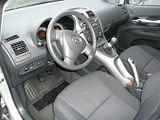
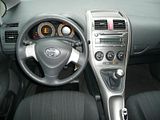
Once on the move, my opinion reverted to the idea that I was driving a slightly revised Corolla again. 1600cc and 110bhp is bang on average for this class of car, and with the sweet and refined engine, it did a perfectly acceptable job at propelling the car. One way it achieves this, for sure, is with rather low gearing. The Auris has a 5 speed gearbox, and I did long for that extra speed when cruising at a steady speed on the German autobahn, especially as 120 km/h was over 4000 rpm. However, I do know that when a sudden burst of acceleration was called for, the gearing as it is proved too high, and even when just a little momentum was lost, it was necessary to drop down a couple of gears and accelerate back up again. No hardship using the gears, as the change quality was very good, but less than restful when trying to make progress on reasonably busy 2 lane motorways. No complaints about the other dynamic attributes – with perfectly acceptable levels of road-holding, handling with a touch of understeer, steering ride and brakes. Just like its antecedent, then, which I assessed similarly. Visibility was good, and I did appreciate the small extra side window in front of the doors. It did add just a bit more of a view to the side – required as a result of the steeper rake to the screen, for sure. Although nothing of the car ahead of the wipers was visible, judging the extremities was easy, and I had no problems in manoeuvering into parking spaces.
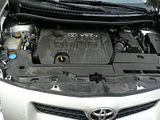
Accepting that this car is not going to be bought by enthusiasts, then to succeed in the market place, it must score high marks for practicality and life serving a family. Here again, I perceived little difference from the last Corolla. There is ample room in the back seats, and a decent sized boot. Regrettably, when you fold the rear seats forward now, although the rear cushion slides forward, they do not lift up, leaving no barrier between the end of the load area and the front seats. The extended floor area is not completely flat, either. There is next to no room under the boot floor, as here a space saver spare can be found, so the mandatory- in-Switzerland warning triangle was left to roll around the boot area.
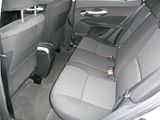
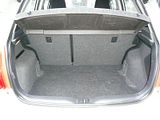
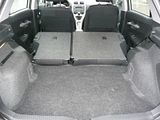
In summary then, perhaps the most radical thing about the Auris is indeed the new name. The styling has been made slightly more interesting outside, and some people may like the new interior, although I did not. No doubt that despite the battered state of the test car, the reliability will remain exemplary, but this really is not enough, as the Auris competes in the mostly hotly contested sector of the new car market, one with some truly excellent alternatives. I’ve now driven most of them, and whereas I would admit that the Auris ownership proposition may raise the score higher than a one day test would lead you to conclude, the Auris did not strike me as a class leader. It remains perfectly acceptable as an automotive white good, for sure, but the Korean duo of i30 and Cee’d strike me as having all the good points of the Toyota, perhaps even better to own with their 7 year warranties, and the Kia (I have yet to drive the Hyundai) was also better to drive. Although a 1.6 petrol is probably not the pick of the range, the Focus still comes across as the best drive of the lot, and I submit remains the car to beat in this class.


























